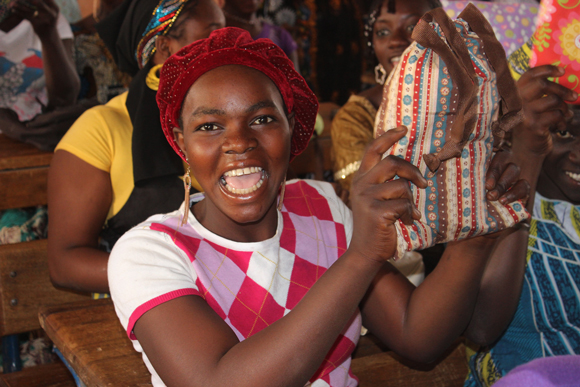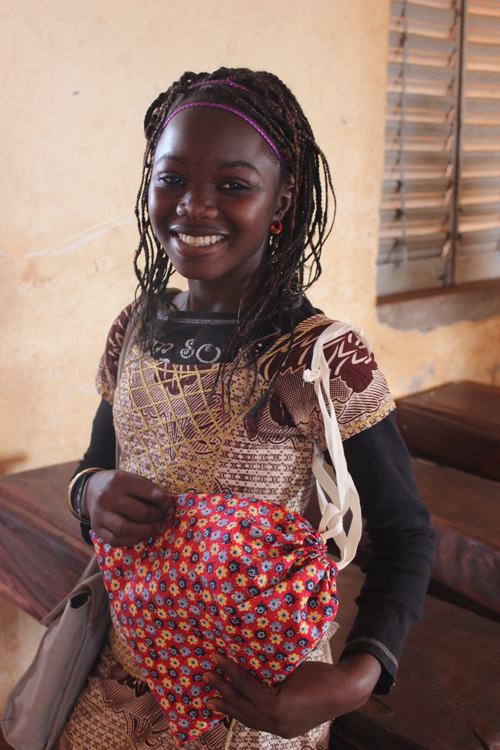When Ann Laemmlen Lewis describes the air in Mali, West Africa, she does it with a smile on her face. “When you get off the plane, it is balmy, hot, warm—and it smells like Africa,” she says, her eyes sparkling. “It’s kind of a musty, earthy smell. It is desolate; it is dry; it is hot; everything is covered in dust. The capital city of Bamako is just wild, crazy, no order—traffic, animals, people. It’s just overload, in a really fun kind of way.” Lewis has lived in Africa for years in the past, but in November 2013, when she and Camille Fronk Olson arrived in Mali, they were excited, for they had come with a very special purpose—to provide sustainable feminine hygiene products to hundreds of women in desperate need.
Lewis and Fronk Olson were in Africa as representatives of a very special organization, Days for Girls. Days for Girls seeks to ameliorate conditions for the millions of women around the world who don’t have access to any sort of feminine hygiene. Lewis is the president of the organization’s Utah Valley chapter, and Fronk Olson was recently recognized as a “Pantie Princess” for donating approximately 5,000 pairs of panties last year alone. As Fronk Olson says of the organization, “I heard about it, and I got so excited I could hardly stand it. It only takes going to Africa once to realize that you are getting more back than you could ever get for yourself, and to realize that we all need to work together.”
A Desperate Need
As Lewis and Fronk Olson explain, when young women in underdeveloped nations like Mali have their periods, many are forced to either stay in bed and sit on some sort of absorbent material (like cardboard) or to use dangerous and unsanitary materials to stop the flow. Girls have been known to use trash, bark, leaves, corn husks, and rags to absorb menstrual fluid. There have even been reports of girls using rocks to block menstruation or crouching over a ditch for days on end. In Ouélessébougou Province, the part of Mali Lewis and Fronk Olson visited, Lewis says, “The people are very, very poor and have little. The girls in these villages have no paper products, no toilet paper. They dig latrines.” Sometimes women wrap sand in a cloth to absorb the flow and sometimes even use cow dung as an absorbent, Lewis says. “One girl . . . came to the clinic, and she had inserted a corncob like a tampon so she could go to school. She was so sore and infected, she could hardly walk. These girls are just desperate to be able to go to school, to have an education,” Lewis relates.
Keeping Girls in School
Regardless of temporary solutions the women find, many are forced to miss days of work and school due to their periods, which results in lost income and fewer educational opportunities. These losses are hardly affordable for girls with very few chances for education in the first place. As Lewis says of her experience in Mali, “This is village life, and the girls have nothing. And they are missing a week of school every month if they even get that far in their education.”
Though Days for Girls seeks to help all women, they focus first on schoolgirls in an effort to keep young women in school. If girls can’t stay in school, many are married off between 13 and 16 to older men in the village, Lewis explains. They get sent to the fields and before long are pregnant and having babies in sub-standard conditions as young teenagers.
“If we can keep the girls in school, it changes their lives drastically. If they are educated, they can earn money, they can find jobs, they can trade and sell in the markets. They can lift themselves out of the poverty cycle that they are in. It changes their whole future. It changes the whole economy. It changes the whole village to have educated mothers and women,” Lewis says.
The Beginning of a Mission
Days for Girls seeks to keep girls in school by providing reusable feminine hygiene kits. Celeste Mergens, the powerhouse behind the kits and the organization, was working to help children at an orphanage in Kenya in 2008 when she woke in the middle of the night with a burning question: “Have you asked what the girls do for feminine hygiene?” When Mergens realized the staggering need for feminine hygiene products in Africa and other developing nations across the globe, Days for Girls was born. Over time, the reusable kit they currently use took shape.
Opening Up a Days for Girls Kit
A beautiful, hand-sewn drawstring bag contains the supplies in each kit, so the girls can carry their feminine products to school. In every bag, volunteers place two hand-sewn shields, eight hand-sewn liners, one pair of panties, and two large Ziploc baggies. Every kit also includes a bar of soap, a washcloth, and a visual instruction sheet with diagrams showing how to use the pads.
Each item in a kit has been chosen and designed with great care. The liners have a special, inconspicuous tri-fold pattern and look somewhat like a handkerchief folded in thirds. This unobtrusive shape allows recipients to wash the liners and hang them out to dry, as cultural taboos regarding menstruation make it difficult for women to have anything that looks period-related in public, even for washing purposes. Shields, essentially liner holders made with a special leak-proof fabric, snap around a pair of panties to keep the liners in place. Both pads and shields are sewn from bright, colorful, patterned fabrics. This makes the kits aesthetically appealing but also serves to help disguise stains that would be readily apparent on white, light-colored, or plain fabric. With proper care and use, one Days for Girls kit can last up to three years.
Those looking to get involved should check out www.daysforgirls.org. If there isn’t a chapter near you, contributors can sew kits and mail them to Days for Girls headquarters. And if sewing isn’t your forte, donations of underwear, 100% cotton fabric, flannel, washcloths, Ziploc baggies, time, and money are happily accepted. As Lewis puts it, “We need all of it. There is something anybody can do to help. People understand the need, and they can see that everything they give helps a girl.” As Fronk Olson adds, “You can do something once, but it’s a drop in a bucket. There’s always more.”
—Amanda Seeley
All photos provided by Days for Girls Organization



I really like how eye opening this article is. It is very easy to take advantage of simple things like feminine hygiene and forget how lucky we are. This article puts things into perspective.
My stake did an activity where we made these kits, and it was really nice to know that we were doing something really worthwhile. This is a very cool project.
This is so inspiring. I really, really love this article. What a great way to get the word out there. I wish I had heard of it sooner! Definitely going to look into helping Days for Girls.